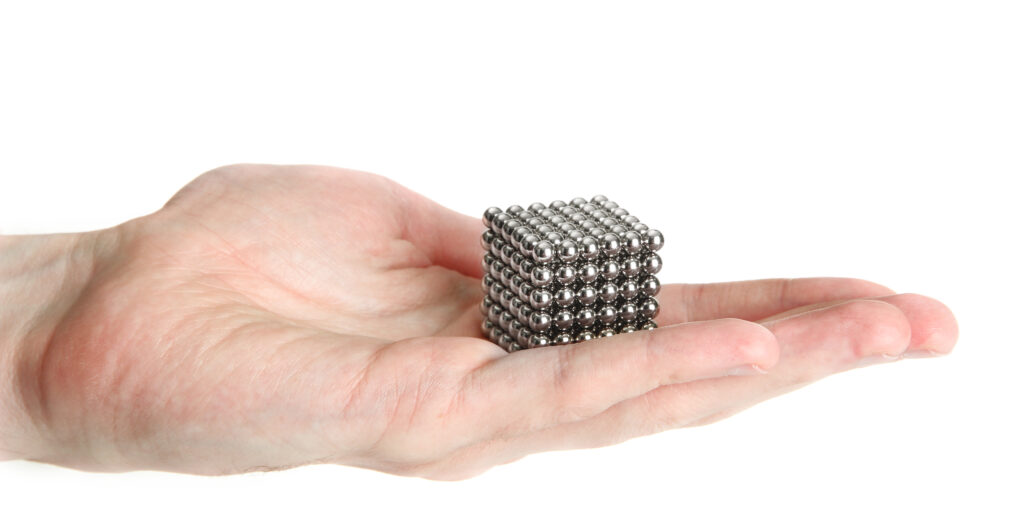Calls to Poison Centers About High-Powered Magnets Increased by 444% After Ban Lifts
Calls to Poison Centers About High-Powered Magnets Increased by 444% After Ban Lifts https://pediatricsnationwide.org/wp-content/uploads/2021/04/AdobeStock_51092262-1024x521.jpeg 1024 521 Laura Dattner Laura Dattner https://pediatricsnationwide.org/wp-content/uploads/2023/03/LauraDattner-web-002.jpg- April 16, 2021
- Laura Dattner

High-powered magnets are small, shiny and made from powerful rare earth metals. Since they started showing up in children’s toys in the early 2000s and then later in desk sets in 2009, high-powered magnets have caused thousands of injuries and are considered to be among the most dangerous ingestion hazards in children.
When more than one is swallowed, these high-powered magnets attract to each other across tissue, cutting off blood supply to the bowel and causing obstructions, tissue necrosis, sepsis and even death. The U.S. Consumer Product Safety Commission (CPSC) found them dangerous enough that in 2012 they halted the sale of high-powered magnet sets and instituted a recall followed by a federal rule that effectively eliminated the sale of these products. This rule was overturned by the U.S. Court of Appeals in December 2016.
A recent study led by researchers at the Center for Injury Research and Policy, Emergency Medicine and the Central Ohio Poison Center at Nationwide Children’s Hospital along with the Children’s Hospital at Montefiore (CHAM) analyzed calls to U.S. poison centers for magnet exposures in children age 19 years and younger from 2008 through October 2019 to determine the impact of the CPSC rule and the subsequent lift of the ban.
The study, recently published in Journal of Pediatrics, found that the average number of cases per year decreased 33% from 2012 to 2017 after high-powered magnet sets were removed from the market. When the ban was lifted and high-powered magnet sets re-entered the market, the average number of cases per year increased 444%. There was also a 355% increase in the number of cases that were serious enough to require treatment in a hospital. Cases from 2018 and 2019 increased across all age groups and accounted for 39% of magnet cases since 2008.
“Regulations on these products were effective, and the dramatic increase in the number of high-powered magnet related injuries since the ban was lifted – even compared to pre-ban numbers – is alarming,” said Leah Middelberg, MD, lead author of the study and emergency medicine physician at Nationwide Children’s. “Parents don’t always know if their child swallowed something or what they swallowed – they just know their child is uncomfortable – so when children are brought in, an exam and sometimes X-rays are needed to determine what’s happening. Because damage caused by magnets can be serious, it’s so important to keep these kinds of magnets out of reach of children, and ideally out of the home.”
The study found a total of 5,738 magnet exposures during the nearly 12-year study period. Most calls were for children who were male (55%), younger than six years (62%), with an unintentional injury (84%). Approximately one-half (48.4%) of patients were treated at a hospital or other healthcare facility while 48.7% were managed at a non-healthcare site such as a home, workplace, or school. Children in older age groups were more likely than younger children to be admitted to the hospital.
“While many cases occur among young children, parents need to be aware that high-powered magnets are a risk for teenagers as well,” says Bryan Rudolph, MD, MPH, co-senior author of this study and gastroenterologist at CHAM. “Serious injuries can happen when teens use these products to mimic tongue or lip piercings. If there are children or teens who live in or frequently visit your home, don’t buy these products. If you have high-powered magnets in your home, throw them away. The risk of serious injury is too great.”
“Significant increases in magnet injuries correspond to time periods in which high-powered magnet sets were sold, including a 444% increase since 2018,” says Dr. Middelberg.
“These data reflect the urgent need to protect children by preventive measures and government action,” Dr. Rudolph emphasizes.
Both Drs. Middelberg and Rudolph support the federal legislation, “Magnet Injury Prevention Act,” which would limit the strength and/or size of magnets sold as part of a set, as well as reinstatement of a CPSC federal safety standard that would effectively restrict the sale of these magnet products in the U.S.
Data for this study were obtained from the National Poison Data System, which is maintained by the American Association of Poison Control Centers (AAPCC). The AAPCC receives data on calls to regional poison control centers that serve the US and its territories. Poison control centers receive phone calls through the Poison Help Line and document information about the product involved, route of exposure, individual exposed, medical outcome, and other data.
Reference:
Middelberg LK, Funk AR, Hays HL, McKenzie LB, Rudolph B, Spiller HA. Magnet Injuries in Children: An Analysis of the National Poison Data System From 2008-2019. The Journal of Pediatrics, 2021;0(0). https://doi.org/10.1016/j.jpeds.2021.01.052
About the author
Laura Dattner, MA, is a research writer in the Center for Injury Research and Policy of the Abigail Wexner Research Institute at Nationwide Children’s Hospital. With both a health communications and public health background, she works to translate pediatric injury research into meaningful, accurate messages which motivate readers to make positive behavior changes.
-
Laura Dattnerhttps://pediatricsnationwide.org/author/laura-dattner/
-
Laura Dattnerhttps://pediatricsnationwide.org/author/laura-dattner/April 4, 2019
-
Laura Dattnerhttps://pediatricsnationwide.org/author/laura-dattner/
-
Laura Dattnerhttps://pediatricsnationwide.org/author/laura-dattner/









